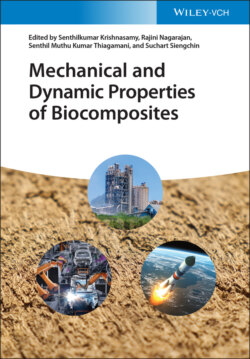Читать книгу Mechanical and Dynamic Properties of Biocomposites - Группа авторов - Страница 10
1.1 Introduction
ОглавлениеThe use of composites in industrial applications has evolved tremendously over the years, due to the quest for better material performance and cost reduction. They have been found to have exceptional properties in terms of their physical and mechanical properties. Simply put, composites describe a heterogeneous material that comprises two or more different materials that are combined within a single system such that the new material formed now has improved properties, which are suitable for an intended application. The materials that are combined to form a composite material are known as fiber and matrix, reinforcement and binder as commonly called, respectively. The matrix material could be either a natural or synthetic polymer, while fiber material could be glass, boron, or carbon, among others (synthetic type); hemp, jute, flax, among natural type; organic; or ceramic [1]. The increasing use of composite materials in industries has been traced to the fact that they have light weight, and possess high strength as well as exceptional corrosion resistance and acoustic properties, which make them preferred to metallic and alloy materials. Their applications now span into marine, power/energy, automobile, security, aerospace, telecommunications, sport/game, military industries, among others.
Biocomposite has been defined as a composite with at least one of its components derived from biological or natural sources [1]. Their main features that drive research interest are the fact that they are biodegradable, renewable, cheap, and have natural/sustainable resources. These features underscore their environmental friendliness. Some examples of natural fibers frequently used in biocomposites are caraua, sisal, jute, abaca, and kenaf, among others [2]. Other natural fibers used in biocomposites are hemp, agave, and flax, among others [3]. Some natural fibers have been identified in the literature to be used only for craft production and these include kenaf, agave, coir, ramie, and caraua fibers [3].
Table 1.1 Commonly used natural fibers and their mechanical behaviors.
Source: Nguyen et al. [4]. © 2017, Elsevier.
| Fiber | Density (g/cm3) | Diameter (μm) | Elongation (%) | Tensile strength (MPa) | Young's modulus (GPa) |
|---|---|---|---|---|---|
| Bast | |||||
| Flax | 1.4–1.5 | 5–38 | 1.2–3.2 | 345–1500 | 27.6–80 |
| Hemp | 1.48 | 10–51 | 1.6 | 550–900 | 70 |
| Jute | 1.3–1.46 | 5–25 | 1.5–1.8 | 393–800 | 10–30 |
| Kenaf | 1.2 | 12–36 | 2.7–6.9 | 295 | — |
| Ramie | 1.5 | 18–80 | 2.0–3.8 | 220–938 | 44–128 |
| Leaf | |||||
| Abaca | 1.5 | — | 3.0–10 | 400 | 12 |
| Banana | 1.35 | 13.16 | 5.3 | 355 | 33.8 |
| Caraua | 1.4 | — | 3.7–4.3 | 500–1150 | 11.8 |
| Henequen | 1.4 | — | 3.0–4.7 | 430–580 | — |
| PALF | 1.5 | 20–80 | 1–3 | 170–1627 | 82 |
| Sisal | 1.33–1.5 | 7–47 | 2.0–3.0 | 400–700 | 9–38 |
| Seed | |||||
| Cotton | 1.5–1.6 | 12–35 | 3.0–10.0 | 287–597 | 5.5–12.6 |
| Fruit | |||||
| Coir | 1.2 | — | 15.0–30.0 | 175–220 | 4–6 |
| Oil palm EFB | 0.7–1.55 | 19.1–25.0 | 2.5 | 248 | 3.2 |
| Wood | |||||
| Softwood kraft pulp | 1.5 | 33 | 4.4 | 1000 | 40 |
| Cane/grass | |||||
| Bagasse | 1.2 | 10–34 | 1.1 | 20–290 | 19.7–27.1 |
| Bamboo | 0.6–1.1 | — | — | 140–230 | 11–17 |
EFB and PALF denote empty‐fruit bunches and pineapple leaf fiber, respectively.
Some interesting mechanical behaviors of commonly used natural fibers and many more that are not aforementioned are shown in Table 1.1.
Biocomposites have found application in many different industrial sectors, including packaging, sports articles, and ship building, but most importantly in civil and automotive sectors for nonstructural applications: soundproofing, filling material, and lightening, among others [3]. They favor applications that require low cost and lightness as compared with any other synthetic fiber‐reinforced composites. They also demonstrate good thermal and acoustic insulation capacities [3]. Generally, biocomposites are randomly oriented with short fibers that are obtained through the extrusion or molding manufacturing process [3]. Essentially, the low specific weight as well as low cost of biocomposites is a function of the low weight and low cost of most natural fibers, in combination with the low cost of the automated manufacturing processes when mass‐producing them [3].
